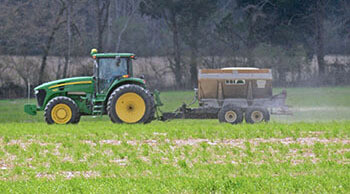Review of Basic pH and Liming Principles
Sep 28, 2020

The practice of using lime to increase crop production dates back to the days of the Roman Empire and most likely even long before then. Most everyone knows liming makes soils better, but ever thought about how or why?
Although lime sources contain calcium, it is the carbonate CO3 present in lime sources that actually does the work of binding to or neutralizing excess hydrogen ions (H+) in the soil. H+ ions accumulate in the soil as a result of natural processes of cropping (such as residue breakdown) as well as the breakdown of applied acid forming fertilizers such as nitrogen and ammonium phosphate sources.
An important consideration when applying lime is to know the quality of the product you are applying. Lime quality can vary greatly. Lime quality is a component of three major factors, which are interrelated.
In Tennessee, the Liming Materials Act sets forth guidelines to help protect farmers and prohibits the sale of poor-quality lime for agriculture use. The act states no lime shall be sold for agricultural use that has a CCE of less than 75, an RNV of less than 65, or if less than 85 percent of the material will pass through a 10 mesh screen, or if less than 50 percent will pass through a 40 mesh screen.
Contact your local agronomist or visit your local Co-op for more information, and to help select the right lime for you.
Although lime sources contain calcium, it is the carbonate CO3 present in lime sources that actually does the work of binding to or neutralizing excess hydrogen ions (H+) in the soil. H+ ions accumulate in the soil as a result of natural processes of cropping (such as residue breakdown) as well as the breakdown of applied acid forming fertilizers such as nitrogen and ammonium phosphate sources.
An important consideration when applying lime is to know the quality of the product you are applying. Lime quality can vary greatly. Lime quality is a component of three major factors, which are interrelated.
- Calcium Carbonate Equivalent (CCE)
- Fineness
- Relative Neutralizing Value (RNV)
In Tennessee, the Liming Materials Act sets forth guidelines to help protect farmers and prohibits the sale of poor-quality lime for agriculture use. The act states no lime shall be sold for agricultural use that has a CCE of less than 75, an RNV of less than 65, or if less than 85 percent of the material will pass through a 10 mesh screen, or if less than 50 percent will pass through a 40 mesh screen.
Contact your local agronomist or visit your local Co-op for more information, and to help select the right lime for you.